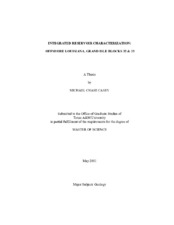| dc.description.abstract | This thesis integrated geology, geophysics, and petroleum engineering data to build a detailed reservoir characterization models for three gas pay sands in the Grand Isle 33 & 43 fields, offshore Louisiana. The reservoirs are Late Miocene in age and include the upper (PM), middle (QH), and lower (RD) sands. The reservoir models address the stratigraphy of the upper (PM) sand and help delineate the lower (RD) reservoir. In addition, this research addresses the partially depleted QH-2 reservoir compartment. The detailed models were constructed by integrating seismic, well log, and production data. These detailed models can help locate recoverable oil and gas that has been left behind.
The upper PM model further delineated that the PM sand has several areas that are shaled-out effectively creating a flow barrier within reservoir compartments. Due to the barrier in the PM-1 reservoir compartment, an area of potentially recoverable hydrocarbons remains. In Grand Isle 33, the middle QH sand was partially depleted in the QH-2 reservoir compartment by a series of development wells. Bottom hole pressure data from wells in Grand Isle 32 & 33 reveal that the two QH fault compartments are in communication across a leaking fault. Production wells in the QH-1 compartment produced reserves from the QH-2 compartment. The lower RD sand model helped further delineate the reservoir in the RD-2 compartment and show that this compartment has been depleted. The RD model also shows the possible presence of remaining recoverable hydrocarbons in the RD-1 compartment. It is estimated that about 6.7 billion cubic feet of gas might remain within this reservoir waiting to be recovered. A seismic amplitude anomaly response from the QH and RD sands is interpreted to be a lithologic indicator rather than the presence of hydrocarbons. Amplitude response from the PM level appears to be below the resolution of the seismic data. A synthetic seismogram model was generated to represent the PM and surrounding sands. This model shows that by increasing the frequency of the seismic data from 20 Hz to a dominant frequency of 30 Hz that the PM and surrounding sands could be seismically resolvable. Also the PM-1 compartment has possible recoverable hydrocarbons of 1.5 billion cubic feet of gas remaining. | en |


